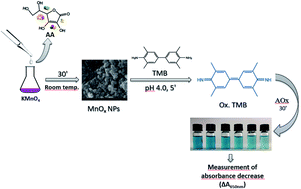当前位置:
X-MOL 学术
›
Anal. Methods
›
论文详情
Our official English website, www.x-mol.net, welcomes your
feedback! (Note: you will need to create a separate account there.)
A manganese oxide (MnOx)-Based colorimetric nanosensor for indirect measurement of lipophilic and hydrophilic antioxidant capacity
Analytical Methods ( IF 2.7 ) Pub Date : 2019/12/19 , DOI: 10.1039/c9ay02027f Kader Can 1, 2, 3, 4, 5 , Ayşem Üzer 1, 2, 3, 4, 5 , Reşat Apak 1, 2, 3, 4, 5
Analytical Methods ( IF 2.7 ) Pub Date : 2019/12/19 , DOI: 10.1039/c9ay02027f Kader Can 1, 2, 3, 4, 5 , Ayşem Üzer 1, 2, 3, 4, 5 , Reşat Apak 1, 2, 3, 4, 5
Affiliation

|
Nanomaterials and composites containing metal oxides are increasingly being used in human health, cosmetics and food packaging applications, which may give rise to the evolution of reactive species on nanosurfaces by autoxidation with air O2. In recent years, novel analytical approaches have been developed for total antioxidant capacity (TAC) determination, with special emphasis on nanoparticle-based sensors due to their low cost, easy use, rapid response and high precision. A nano-manganese oxide (nano-MnOx)-based spectrophotometric method was developed for the indirect capacity measurement of antioxidant compounds, based on the measurement of the decrease in the color intensity (at λmax = 650 nm) of 3,3′,5,5′-tetramethylbenzidine cations (TMB+) in the presence of hydrophilic and lipophilic antioxidants. TMB+ cations were obtained via a redox reaction between MnOx NPs and the TMB chromophore in open air, and antioxidants caused a decrease of TMB+ color intensity. MnOx NPs could be easily and rapidly prepared at low cost. The linearity, repeatability and recovery parameters defining reliability and precision were tested to validate the sensing method. Depending on the type of tested antioxidant, the limit of detection (LOD) values were in the range of 1.23 × 10−9 to 1.71 × 10−7 mol L−1. The developed nanoprobe was applied to ternary synthetic mixtures of antioxidants to yield expected and found TAC values (as trolox-equivalents) in agreement. The potential interferents such as benzoic acid, citric acid, glucose and mannitol did not adversely affect the TAC determination. To test real samples, the method of standard addition of pure antioxidant compounds was applied to real samples such as green tea and orange juice.
中文翻译:

一种基于锰氧化物(MnOx)的比色纳米传感器,用于间接测量亲脂性和亲水性抗氧化能力
包含金属氧化物的纳米材料和复合材料正越来越多地用于人类健康,化妆品和食品包装应用中,这可能会导致通过空气O 2的自氧化而在纳米表面上形成反应性物种。近年来,已经开发出了用于总抗氧化剂容量(TAC)测定的新颖分析方法,由于其低成本,易于使用,快速响应和高精度,特别强调了基于纳米颗粒的传感器。所述的纳米氧化锰(纳米的MnO X)基分光光度法是为抗氧化剂化合物的间接测量容量的发展,基于在颜色强度的降低的测量(在λ最大= 650纳米)的3,3' ,5,5'-四甲基联苯胺阳离子(TMB+)在亲水性和亲脂性抗氧化剂的存在下。TMB +阳离子是通过MnO x NP与露天TMB生色团之间的氧化还原反应获得的,抗氧化剂导致TMB +颜色强度降低。MnO x NPs可以轻松,快速地以低成本制备。测试了定义可靠性和精度的线性,可重复性和恢复参数,以验证感测方法。根据测试的抗氧化剂的类型,检出限(LOD)值在1.23×10 -9至1.71×10 -7 mol L -1的范围内。将开发的纳米探针应用于抗氧化剂的三元合成混合物,以产生预期的和发现的TAC值(以trolox当量计)。潜在的干扰物(例如苯甲酸,柠檬酸,葡萄糖和甘露醇)不会对TAC测定产生不利影响。为了测试真实样品,将标准抗氧化剂化合物的添加方法应用于真实样品,例如绿茶和橙汁。
更新日期:2020-02-13
中文翻译:

一种基于锰氧化物(MnOx)的比色纳米传感器,用于间接测量亲脂性和亲水性抗氧化能力
包含金属氧化物的纳米材料和复合材料正越来越多地用于人类健康,化妆品和食品包装应用中,这可能会导致通过空气O 2的自氧化而在纳米表面上形成反应性物种。近年来,已经开发出了用于总抗氧化剂容量(TAC)测定的新颖分析方法,由于其低成本,易于使用,快速响应和高精度,特别强调了基于纳米颗粒的传感器。所述的纳米氧化锰(纳米的MnO X)基分光光度法是为抗氧化剂化合物的间接测量容量的发展,基于在颜色强度的降低的测量(在λ最大= 650纳米)的3,3' ,5,5'-四甲基联苯胺阳离子(TMB+)在亲水性和亲脂性抗氧化剂的存在下。TMB +阳离子是通过MnO x NP与露天TMB生色团之间的氧化还原反应获得的,抗氧化剂导致TMB +颜色强度降低。MnO x NPs可以轻松,快速地以低成本制备。测试了定义可靠性和精度的线性,可重复性和恢复参数,以验证感测方法。根据测试的抗氧化剂的类型,检出限(LOD)值在1.23×10 -9至1.71×10 -7 mol L -1的范围内。将开发的纳米探针应用于抗氧化剂的三元合成混合物,以产生预期的和发现的TAC值(以trolox当量计)。潜在的干扰物(例如苯甲酸,柠檬酸,葡萄糖和甘露醇)不会对TAC测定产生不利影响。为了测试真实样品,将标准抗氧化剂化合物的添加方法应用于真实样品,例如绿茶和橙汁。











































 京公网安备 11010802027423号
京公网安备 11010802027423号